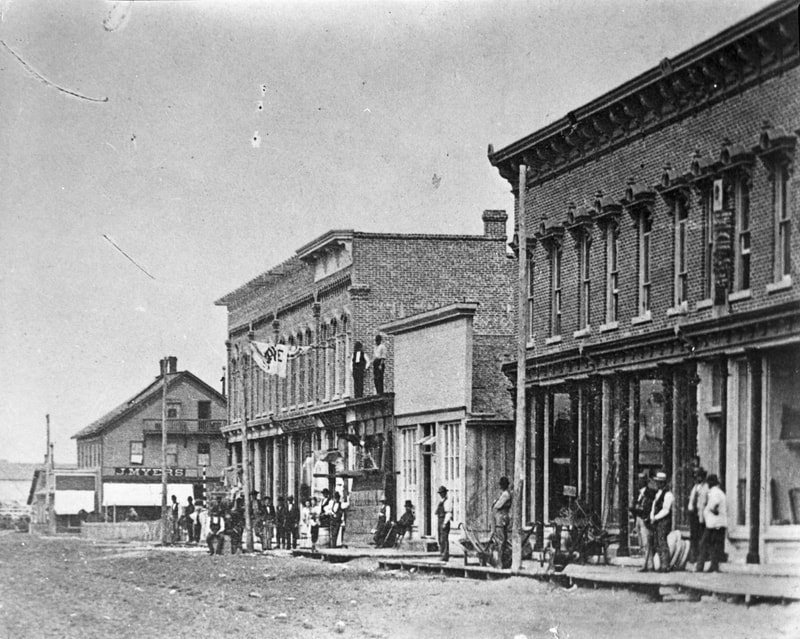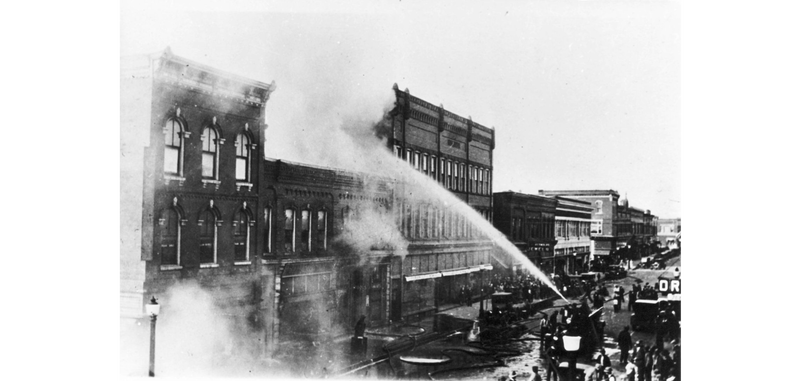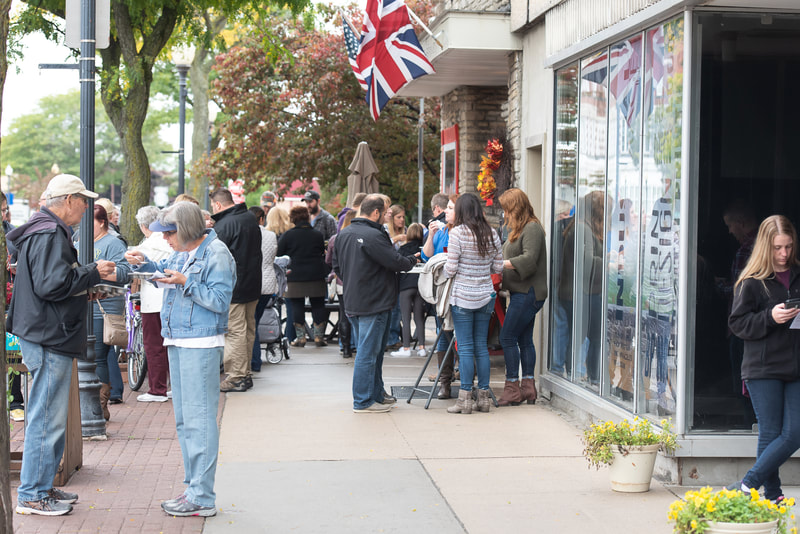Downtown Alpena has been the economic hub of the Northeast Michigan region since the late 1800's due to its strategic location on the Thunder Bay River and Lake Huron. Since then, our downtown has reflected the changing economies of the Alpena area and changing consumer habits that have played out on a much-larger national level.
The Alpena Downtown Development Authority (DDA) was established in 1980 to lead the cause to revitalize our downtown and encourage the stewardship of our historic buildings, foster community ownership and investment, and develop an economically diverse district.
In the last ten years, we have seen these efforts- many of which were put into motion over forty years ago- flourish. Our community is taking ownership of our downtown, realizing we all have a role to play to continue its positive growth and sustainable development. Our district is home to nearly 200 businesses, non-profits, stores, offices, restaurants, theaters and more, nearly 50 units of housing, and home to over 800 employees who make downtown run. In 2023, our DDA boundaries were expanded to include two additional key corridors in Alpena: North Second Avenue and Chisholm St.
Learn more about the different chapters in Downtown Alpena's history below.
Thank you to the Alpena County George N. Fletcher Public Library Edith & Angell R. Cook Special Collections for providing the historic photos and the historical information you see on this page!
The Alpena Downtown Development Authority (DDA) was established in 1980 to lead the cause to revitalize our downtown and encourage the stewardship of our historic buildings, foster community ownership and investment, and develop an economically diverse district.
In the last ten years, we have seen these efforts- many of which were put into motion over forty years ago- flourish. Our community is taking ownership of our downtown, realizing we all have a role to play to continue its positive growth and sustainable development. Our district is home to nearly 200 businesses, non-profits, stores, offices, restaurants, theaters and more, nearly 50 units of housing, and home to over 800 employees who make downtown run. In 2023, our DDA boundaries were expanded to include two additional key corridors in Alpena: North Second Avenue and Chisholm St.
Learn more about the different chapters in Downtown Alpena's history below.
Thank you to the Alpena County George N. Fletcher Public Library Edith & Angell R. Cook Special Collections for providing the historic photos and the historical information you see on this page!
1850's-1890's: building downtown
Lumberjacks, saloons, and miles of lumber floating down the river are images that come to mind when thinking of Downtown Alpena's early days. The abundance of virgin softwood and white pine in Northeast Michigan drew lumber businesses to the region from the Eastern US beginning in the 1850's. Through the 1890's, the booming lumber industry solidified Alpena's status as the "Metropolis of the North."
Because of its strategic location- where the Thunder Bay River watershed terminates in Thunder Bay into Lake Huron- lumber mills and factories filled the riverfront area downtown. "Downtown" as we know it was built up around the river to accommodate the commercial needs of businessmen and new residents to the area. Buildings were built that housed new businesses from dry good stores harness shops to saloons to churches. Since then, Second Ave (originally known as Dock St north of the river) has been the commercial core of the community.
Because of its strategic location- where the Thunder Bay River watershed terminates in Thunder Bay into Lake Huron- lumber mills and factories filled the riverfront area downtown. "Downtown" as we know it was built up around the river to accommodate the commercial needs of businessmen and new residents to the area. Buildings were built that housed new businesses from dry good stores harness shops to saloons to churches. Since then, Second Ave (originally known as Dock St north of the river) has been the commercial core of the community.
late 1800's: fires
"Alpena has been a great sufferer of fires. Perhaps no place of its age and population has been visited by the fire king so often, and with such terrible effect, as Alpena." - Centennial History of Alpena County, David D. Oliver
Throughout the decades, fires tore through downtown, forever changing the downtown landscape. Most significantly, two fires in the 1870's completely destroyed downtown and its wooden frame buildings. An 1871 fire destroyed the commercial buildings on the north side of the river on Second Ave. Just a year later in 1872, another fire that started in the stables of the Sherman House destroyed 75 businesses and residences along the south side of the river, leaving four people dead.
These fires shaped the future of downtown, as the newly formed City government established a city fire department, purchased a steam fire engine, and enacted new building codes that required new buildings be built in the more fire-safe brick. You can see the effects of these new codes, as many of our oldest buildings that still stand downtown today were built in brick as a result of these fires, such as Thunder Bay Theatre (400 N. Second Ave. built 1904).
Throughout the decades, fires tore through downtown, forever changing the downtown landscape. Most significantly, two fires in the 1870's completely destroyed downtown and its wooden frame buildings. An 1871 fire destroyed the commercial buildings on the north side of the river on Second Ave. Just a year later in 1872, another fire that started in the stables of the Sherman House destroyed 75 businesses and residences along the south side of the river, leaving four people dead.
These fires shaped the future of downtown, as the newly formed City government established a city fire department, purchased a steam fire engine, and enacted new building codes that required new buildings be built in the more fire-safe brick. You can see the effects of these new codes, as many of our oldest buildings that still stand downtown today were built in brick as a result of these fires, such as Thunder Bay Theatre (400 N. Second Ave. built 1904).
early 1900's: cement, limestone, and economic transition
As the forests fell, lumber businesses moved westward and mills closed. The economy of Alpena stagnated from the 1900's-1910's until a new industry emerged that still serves the region today: limestone.
The limestone deposits in the region became valuable to produce soda ash used in glass manufacturing. Byproducts were then used to manufacture and sell cement with the creation of the Huron Portland Cement Company in 1906. While this was happening, Hermann Besser bought his first crude block-making machine in 1902 with his son Jesse. The pair improved the design over the next years and created the Besser Company, which is still a major employer in the Alpena area today.
Throughout the first half of the century, downtown remained the economic hub of Alpena, as the City had yet to stretch beyond Ripley Blvd or into the commercial corridors we know today, such as M-32 and US-23 South. Automobiles had yet to become part of the American lifestyle, and development was centered around the downtown core.
The limestone deposits in the region became valuable to produce soda ash used in glass manufacturing. Byproducts were then used to manufacture and sell cement with the creation of the Huron Portland Cement Company in 1906. While this was happening, Hermann Besser bought his first crude block-making machine in 1902 with his son Jesse. The pair improved the design over the next years and created the Besser Company, which is still a major employer in the Alpena area today.
Throughout the first half of the century, downtown remained the economic hub of Alpena, as the City had yet to stretch beyond Ripley Blvd or into the commercial corridors we know today, such as M-32 and US-23 South. Automobiles had yet to become part of the American lifestyle, and development was centered around the downtown core.
post ww2: modernization of downtown alpena
The 1950's through 1970's were a period of growth for Alpena, as the City's population peaked at 14,600. Downtown saw this growth too.
During this period, many downtown facades changed due to the "modernization" efforts, as the original brick facades were seen as old and outdated. To compete for the modern customer, downtown property owners "modernized" their facades and updated their buildings to mark a new period of American consumerism.
During this period, downtown became a retail hub, home to locally-owned shops like Martinson's, Tony and Norm's, and chain department stores like Gately's, Vaughn's, Montgomery Ward. In this time period, City and business leaders invested in a series of plans that sought to "modernize" downtown through a series of planned improvements, from re-routing traffic around the core to create a "business loop," to reclaiming the riverfront space as park-space, to tearing down deteriorating buildings to make their way for public parking.
During this period, many downtown facades changed due to the "modernization" efforts, as the original brick facades were seen as old and outdated. To compete for the modern customer, downtown property owners "modernized" their facades and updated their buildings to mark a new period of American consumerism.
During this period, downtown became a retail hub, home to locally-owned shops like Martinson's, Tony and Norm's, and chain department stores like Gately's, Vaughn's, Montgomery Ward. In this time period, City and business leaders invested in a series of plans that sought to "modernize" downtown through a series of planned improvements, from re-routing traffic around the core to create a "business loop," to reclaiming the riverfront space as park-space, to tearing down deteriorating buildings to make their way for public parking.
1980's: the shopping mall and downtown decline
You can't talk about the history of Downtown Alpena without talking about the Alpena Mall. In 1983, the Alpena Mall opened on the outskirts of the City and with it, took downtown anchors such as J.C. Penney. Over the next decade, downtown would decline as retail stores that populated downtown closed their doors, unable to compete with the big-box development happening along the US-23 South Corridor.
2000's- now: downtown renaissance
In 1980, Alpena City Council established the Alpena Downtown Development Authority (DDA) to address the deterioration of downtown that had begun as businesses relocated out of the downtown district into the newly developed US-23 corridor- or closed their doors, unable to compete. Since the DDA's creation, the DDA's volunteers and staff had lead programs, events, beautification projects, and grant opportunities to bring people, businesses, and investments back into the historic downtown district. In the early 2000's, historic preservation or "old-fashioned fix-ups" started to take on momentum, and property owners began to remove the "modernized" facades and rehabilitate the historic buildings underneath, with the Center Building leading the charge.
In 2021, the Alpena Mall announced its closing. Anchors like Glik's, Prattscape, and others moved into the downtown, along with 10+ other businesses that opened during the Covid-19 pandemic.
In the last five years, our downtown has continued to grow as the community has re-realized the value of downtown as a vital community center. Now home to nearly 200 businesses, 15+ pieces of public art, year-round festivals and events, and 800+ employees, Downtown Alpena continues to thrive. The work to keep downtown thriving is never finished. Opportunities abound for redevelopment and preservation, with key sites like the Fletcher Paper Mill, Vaughn building, State Theatre, and properties along Chisholm St. to 14th Ave. and Second Ave. to Lake St.
With the strides made in the last decades, are excited about the future of downtown as the community reinvests into this historic heart of Alpena and realizes the immense historic, cultural, and social significance it plays in our community.
In 2021, the Alpena Mall announced its closing. Anchors like Glik's, Prattscape, and others moved into the downtown, along with 10+ other businesses that opened during the Covid-19 pandemic.
In the last five years, our downtown has continued to grow as the community has re-realized the value of downtown as a vital community center. Now home to nearly 200 businesses, 15+ pieces of public art, year-round festivals and events, and 800+ employees, Downtown Alpena continues to thrive. The work to keep downtown thriving is never finished. Opportunities abound for redevelopment and preservation, with key sites like the Fletcher Paper Mill, Vaughn building, State Theatre, and properties along Chisholm St. to 14th Ave. and Second Ave. to Lake St.
With the strides made in the last decades, are excited about the future of downtown as the community reinvests into this historic heart of Alpena and realizes the immense historic, cultural, and social significance it plays in our community.






















